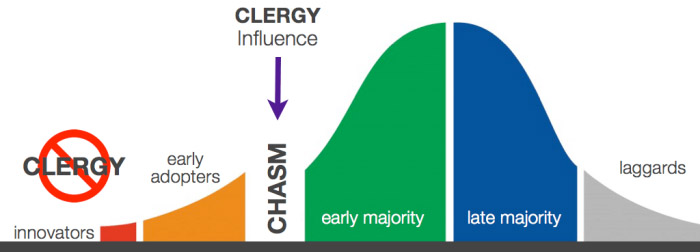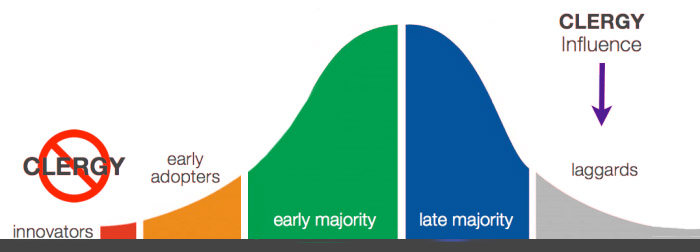Why Transformation in the ELCA Is Unlikely
The Southeastern Pennsylvania Synod of the Evangelical Lutheran Church in America (SEPA / ELCA) recently posted a link on its Facebook page from a Methodist Conference that discussed the role of clergy in church transformation.
It referenced the work of Everett M. Rogers, Diffusion of Innovations. His work studied innovation in farming.
Rogers found the implementers of new ideas broke into the following categories:
- 2.5% were Innovators. They were educated, had means and were risk-oriented.
- Early Adopters followed them. They were young, educated and community leaders.
- Then came the Early Majority. They were conservative but open to new ideas.
- The Late Majority were older, less educated, conservative and less socially active.
- Laggards were very conservative had the smallest farms and little capital.
The article argued that clergy could not be effective innovators within their parish role. They place the clergy somewhere between early adopters and the effective implementation that follows.
 Perhaps this is true within Methodist circles.
Perhaps this is true within Methodist circles.
The Lutheran Bell Curve would probably find clergy at the other end of the spectrum. It is probably a disproportionate number, eating into the hump of the Bell Curve.
- Lutheran clergy, at least in our area, are older.
- Lutheran churches in our area are smaller.
- Lutheran leaders at every level are desperate for capital. That equity should be a tool for the congregation’s use, but regional bodies covet it.
- Lutheran clergy, by some measure, are less socially active. (Search Lutheran clergy on LinkedIn and see how many are connected and how many of them post their profiles publicly.)
- Lutheran clergy are becoming increasingly enamored with and dependent upon hierarchy which makes them less likely to explore risk. Innovation without risk is unlikely.
Given these factors, the Lutheran Church will lag in innovation if we depend on professional leaders. Clergy already turn to laity for implementation of most church work. But the control reins hold them back.
Add a few other factors. Lutheran regional leadership, desperate for capital, hover over member congregations waiting for signs of failure. The incentive to assist with innovation is not there. Innovation takes capital! Most of that capital tends to go toward salaries with inconsequential accountability.
Caretaker and part-time ministries rarely lead to innovation but they abound. Pastors inclined toward innovation must be careful. Would-be innovators do so in an unfair arena where leadership is protected by separation of church and state and lay innovators accept personal risk. They may not know it! Ask the laity of Redeemer in East Falls who were named personally in lawsuits by SEPA Synod, while the actions of clergy were protected under separation of church and state.
Laity step up when caretaker ministries are in place, but their leadership is often unappreciated by clergy, who even with part-time status want full-time oversight and credit for success. Failure? The laity can take the credit for that!
Beware! Laity inclined toward innovation do so at their own risk. They may even risk the mission of the church if their leadership threatens the perceived turf of professional leaders.
Yet transformation is not going to happen without a fully empowered laity.
Dedicated laity bring skills to the table that the church desperately needs. When they go unappreciated or are seen as threatening, innovation is squashed.
Laggards swim in the wake. They see the opportunity to sustain things as they are by seizing property, capital and equity.
Consequently, transformation will not happen any time soon. Talk won’t get you there! Visibly aligning with the few charismatic rising stars among the clergy won’t work either. Feature them at Synod Assemblies and Bishop’s Convocations and hope their energy fuels a local movement. Will it catch on without an infrastructure to support it? Not likely. Looks good, though!
This is 2×2’s (Redeemer’s) experience in the ELCA.
Our ministry was already getting attention for innovation back in 2006.
Enter SEPA Synod with its recurring six-figure annual deficit, legal team and locksmith.
SPLAT!
The Lutheran Church desperately needs to empower the laity. They just don’t know how.

